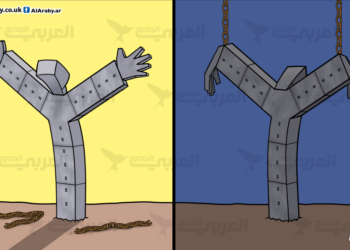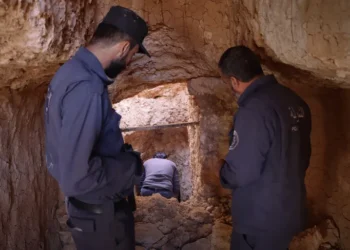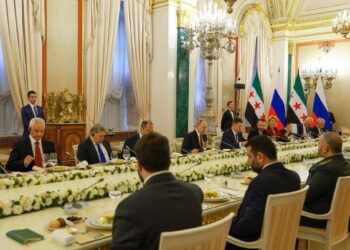Since becoming “First Lady” of Syria, Asma al-Assad has invested in cultivating a glamorous image as a champion of humanitarian causes. She has presented herself to the international community as a symbol of change and reform in Syria, and to this end, she has engaged expensive public relations firms, such as Bell Pottinger, a “reputation management and marketing” firm, one of whose founders advised former British Prime Minister Margaret Thatcher. Vogue magazine has described her as “a rose in the desert.” The outbreak of the Syrian revolution in 2011, caused a gradual change to her image, particularly with Asma’s insistence on standing by her husband in his bloody suppression of the Syrian people, despite receiving an offer of safe passage out of Syria with her children to live a dignified life in her native Britain.
Asma not only stood by her husband, but also directly contributed to oppressing the Syrian people and exacerbating their suffering by establishing an economic empire through which she systematically plundered the country’s wealth, including international aid originally intended for the afflicted Syrian people.
Through a complex network of economic monopolies, forced donations from businessmen, and the deliberate exploitation of humanitarian resources, Asma al-Assad amassed a vast personal fortune, coinciding with Syria’s descent into one of the most serious humanitarian crises in contemporary history. The February 2023 earthquake disaster, which devastated large parts of Syria, provided an additional opportunity for exploitation, as international aid was hoarded or diverted to benefit the Assad regime instead of reaching victims in need.
Asma al-Assad’s story is not only an isolated case of personal corruption; it also highlights the extent to which humanitarian organizations can be exploited by authoritarian regimes as tools to consolidate their grip on power and accumulate wealth. By December 2024, when the Assad family hastily fled Syria, they left behind damning evidence of the extent of this exploitation. This article discusses how Asma al-Assad systematically transformed humanitarian organizations into platforms for theft.
Economic Exploitation
In addition to controlling humanitarian aid, the Syria Trust for Development has tightened its grip on key economic sectors and cultural spaces across Syria. Under Asma al-Assad’s leadership, the organization has imposed its control over markets, cultural landmarks, and development projects, enabling it to establish a vast economic empire through which it has generated enormous profits, under the guise of civil and development activities.
The Trust’s economic activities diversified, with profit-making projects disguised as humanitarian initiatives. For example, Diari, a construction company affiliated with the Trust, served as Asma al-Assad’s primary economic arm in the construction and restoration sector. Despite the organization’s self-described non-profit status, Diari consistently received UN-funded rehabilitation contracts, including a $400,000 contract to rehabilitate shelters. The profits went directly to the organization, and subsequently to Asma al-Assad herself.
Among the most prominent projects of the “Trust” that have become a huge source of profit are the microfinance programs. Although these programs are presented in the media as initiatives aimed at alleviating poverty, in practice they generate profits that rival those of traditional financial institutions by imposing interest rates on the most vulnerable groups. In Old Aleppo, for example, the “Trust” provided loans to small business owners for reconstruction at a 5% interest rate, resulting in a steady stream of revenues, exploiting the devastation caused by the regime’s military operations. The “Trust” also operated other economic projects under the umbrella of the “National Marketing Corporation,” such as “Ubbaha,” “Syria for Handicrafts,” and “The National Company,” all of which operate with extreme secrecy about financial details.
Extortion Networks and the Humanitarian Facade
Perhaps the most dangerous of all was the role played by the National Security Agency in carrying out systematic extortion operations targeting the Syrian business community. Wealthy businessmen were asked to pay large sums of money annually, ranging between $200,000 and $1 million, under the guise of “donations.” In reality, these payments were more like protection money, guaranteeing them privileges and services from the presidential palace.
This organized extortion created an economic situation similar to the workings of a mafia, with Asma al-Assad’s power centered around her, allowing her to dominate key aspects of the Syrian economy while amassing a vast personal fortune under the guise of humanitarian and charitable work. The effectiveness of this system relied on making Syrian businessmen understand that their economic survival was directly linked to maintaining positive relations with Asma al-Assad and contributing generously to her ‘charity’.
One of the most prominent features of Asma al-Assad’s strategy was the construction of an elaborate humanitarian facade to whitewash the brutal image of the Syrian regime. Although the Syria Trust for Development was officially registered under Law No. 93 of 1958, which explicitly prohibits registered organizations from engaging in any political activity, it actually served as a direct political tool of the regime, presenting itself as an independent humanitarian organization. The Syria Trust organized pro-regime demonstrations and led propaganda campaigns in support of the regime both domestically and abroad.
Asma al-Assad’s speeches at the organization’s events often included explicit political messages, praising her husband’s “steadfast leadership” in the face of “foreign conspiracies,” while ostensibly addressing humanitarian projects. The clear contradiction between these political messages and the organization’s official, non-political mandate reveals its true function as a propaganda tool for managing and polishing the regime’s image.
At the international level, it sent representatives to European and international events to promote the regime’s narratives under the guise of civil society work. The organization participated in exhibitions in the UAE, sent Syrian handicrafts to exhibitions in Italy, and ensured its presence at international cultural events, seeking to indirectly link Syrian cultural heritage to the image of the Assad regime.
Exploiting national tragedies has also become a well-established method for raising funds, while severely under-reporting the victims. Following the devastating earthquake that struck several areas in Syria in February 2023, international aid channeled through the Trust failed to effectively reach those affected and was either stored or diverted for other purposes. Similarly, when forest fires swept through the Syrian coast (which Asma herself was accused of causing), the Trust managed to collect approximately eight billion Syrian pounds (about three million dollars) in donations.
However, the compensation provided to the affected farmers was humiliatingly low, amounting to no more than 24,000 Syrian pounds per cow (despite its price exceeding three million Syrian pounds), and 600 Syrian pounds per kilogram of olives (which were then valued at approximately 85,000 Syrian pounds). Even this meager compensation was delayed for several months or diverted to ineffective in-kind assistance, such as agricultural tools, rather than direct financial support.
This approach of exploiting disasters has extended to other tragedies. Following the bombing of the Military Academy in Homs in 2023, approximately two billion Syrian pounds were collected from donors through the Homs Chamber of Commerce. However, pro-regime social media accounts confirmed that these funds never reached the families of the dead and wounded, but were instead directed to the Directorate of Guidance for other undisclosed purposes.
Aid Distribution Policies
Under Asma al-Assad’s leadership, humanitarian aid distribution has become a sophisticated political tool that systematically rewards loyalty and punishes dissent. The Syria Trust for Development and the Syrian Arab Red Crescent have completely abandoned fundamental humanitarian principles such as neutrality, independence, and impartiality, and are now applying distribution criteria that directly serve the regime’s political and military interests.
Aid was distributed according to a clear political hierarchy. Documented cases revealed how UN aid was deliberately directed to pro-regime areas, while being completely withheld from communities suspected of sympathizing with the opposition. This approach extended to families, with families with members detained or wanted by security forces systematically excluded from beneficiary lists, effectively imposing a form of collective punishment on entire families.
The ‘Wasta’ system, a prominent form of favoritism based on personal relationships with influential officials, has exacerbated the corruption in aid distribution to a significant degree. Even among regime loyalists, access to humanitarian aid was not based on actual need, but rather on an individual’s closeness to influential figures and security officials. Numerous testimonies from regime supporters themselves confirmed that they were denied aid, despite meeting the eligibility criteria, simply because they lacked the personal connections to facilitate access.
Military personnel and their families received top priority for aid, reflecting the absolute priority the regime accords to its security and military institutions. In 2014, the Syria Trust for Development launched the “Wounded of the Nation” program, which provided medical care and prosthetic limbs to injured regime soldiers and established a special identification card system granting them preferential privileges and services. The organization also held frequent social events to honor the children of military personnel, further strengthening the status of the army and security services at the expense of other segments of society.
Perhaps the most discriminatory and arbitrary practices were applied against those displaced from areas previously under opposition control. Displaced people from these areas faced systematic obstacles that prevented them from receiving any assistance, despite being among the most vulnerable. The situation was exacerbated by the organization’s monopoly on legal support services provided to these displaced people through the “First Legal Response” program. This created a cruel irony, forcing these displaced people, who were displaced by regime violence, to seek assistance from an organization headed by the wife of the official responsible for their displacement. This arrangement enabled the regime to continue monitoring and controlling these groups, in addition to opening the way for further political and economic exploitation.
The regime also periodically manipulated the lists of aid recipients, removing the names of genuine beneficiaries and replacing them with fake names, pro-regime families, affiliated militia members, or members of the Ba’ath Party. A report by the Syrian Network for Human Rights revealed that these tactics were being practiced in all areas under regime control, with food aid and other relief supplies routinely diverted to military units, militia members, and their families. Thus, humanitarian aid was transformed from a need-based right into a political privilege conditional on loyalty, representing a fundamental distortion of humanitarian principles and contributing to the regime’s consolidation of power and the punishment of any potential opposition.
The exploitation of aid became evident after the February 2023 earthquake disaster. Reliable sources confirm that the vast majority of humanitarian aid provided to Syria remained stored in warehouses, or large portions were diverted to bolster the regime’s military and security capabilities. The names of those truly affected were systematically removed from the beneficiary lists, and aid was distributed based on political considerations that bore no relation to humanitarian standards.
Accumulated Wealth
By the time they fled Syria in December 2024, the Assad family had amassed a vast fortune, estimated by sources to be close to $120 billion—a staggering sum for a family that ruled a war-torn country, devastated by economic collapse, and whose people suffered from abject poverty. This wealth, accumulated through decades of systematic corruption, included approximately 200 tons of gold, billions of euros in cash, and luxury real estate in several countries.
The transfer of this wealth abroad accelerated as the regime’s stability became increasingly fragile. According to a Financial Times investigation, the Assad regime airlifted approximately $250 million in cash to Moscow in 2018 and 2019 alone, equivalent to approximately two tons of $100 and €500 banknotes. This money was deposited in sanctioned Russian banks, beyond the reach of Western financial systems.
In addition to direct cash transfers, the Assad family employed a complex network of proxy individuals and front companies to conceal and protect its wealth. Asma al-Assad was particularly adept at using these complex financial mechanisms, remaining off US sanctions lists until 2020 despite her central role in the regime’s economic activities. During this period of relative impunity, she succeeded in consolidating her influence over broad sectors of the Syrian economy, such as real estate, banking, and telecommunications, using front companies and close associates that helped conceal her direct involvement in these operations.
The family’s sudden escape in December 2024 left behind damning evidence revealing the family’s lavish lifestyle and hidden wealth. Sky News journalists, who were granted access to one of the Assad family’s homes, reported discovering “astonishing” bank records maintained in Asma al-Assad’s maiden name, showing vast sums of money that were in stark contrast to the public image she had been promoting of a modest, middle-class life. The floor of the house was also reportedly lined with countless boxes of jewelry, antiques, and luxury goods, clearly revealing the huge gap between the family’s public image and its actual reality.
These discoveries confirmed what Syrians had long suspected: at a time when the country was suffering from conflict, sanctions, and economic collapse, the Assad family was basking in luxury and systematically transferring national wealth abroad to serve its own interests. The Syria Trust for Development served as a vital conduit for this system of economic exploitation, enabling the regime to obtain international funding and conceal its economic activities despite the sanctions, while maintaining a humanitarian appearance acceptable to the international community.
The Economic Empire
Asma al-Assad’s economic journey began with the establishment of the Syrian Fund for Rural Development (FIRDOS) on July 15, 2001. This seemingly simple initiative, focusing on development projects in Idlib, Homs, Hama, and the Damascus countryside, was merely the starting point for what would later become a systematic control over the Syrian civil society sector.
The fund’s transformation from a limited initiative into a center of broad influence accelerated in April 2007, when it became the “Syria Trust for Development.” This provided Asma al-Assad with the appropriate legal framework to expand her influence beyond her usual charitable activities. The trust was promoted in the media as a supporter of local initiatives, active citizenship, and strengthening the role of civil society in development and decision-making. This rhetoric deliberately obscured the true purpose of its establishment: strengthening the regime’s economic and political control.
Perhaps the most prominent manifestation of this influence is Asma al-Assad’s strategy of acquiring numerous Syrian non-governmental organizations (NGOs), bringing them under one umbrella. By 2007, the “Trust” had already absorbed numerous civil society initiatives and become a massive conglomerate with approximately 700 employees. This unification was not merely an administrative restructuring; rather, it was a deliberate means of preventing the emergence of independent civil society organizations. It also resulted in a near-total monopoly on civil society activities, while systematically preventing independent organizations from accessing international funding opportunities.
By 2010, the “Trust,” as it came to be known, effectively controlled a development fund worth approximately $3 million, representing roughly 80% of the total funding allocated to civil society organizations in the country. This monopoly enabled Asma al-Assad to exploit the humanitarian crisis that subsequently swept Syria, channeling international aid through her foundation and determining who received and who was denied support.
To achieve this dominance, she adopted two main strategies: the first was to bring existing initiatives under the umbrella of her organization, providing them with special privileges and legal protections in exchange for operating under the supervision of the Ministry of Defense. The second was to use her influence in the presidential palace to impose regulatory, security, and financial restrictions on independent initiatives. The message was clear: join Asma’s empire or face systematic marginalization.
The Trust and the Syrian Arab Red Crescent have become the primary instruments through which the Assad regime, and Asma al-Assad in particular, monopolizes control over the flow of international humanitarian aid into Syria. According to a report by the Syrian Network for Human Rights, the Assad regime has deliberately obligated UN agencies and donors to work exclusively with these two institutions, making them the mandatory gateways for all humanitarian projects in areas under its control. This monopoly has been entrenched through formal agreements requiring international agencies to obtain prior approval from these two institutions before implementing any project or conducting field visits.
This monopoly has helped both organizations seize more than a quarter of a billion dollars in humanitarian aid provided by UN agencies alone between 2011 and 2023. The figure is likely higher, given that the UN does not disclose all funds provided for this purpose.
This control was reinforced by granting the “Trust” exceptional privileges, including extensive security facilities and legal powers denied to other organizations. By 2018, the Ministry of Social Affairs and Labor had issued circulars prohibiting any organization, except the “Syrian Trust” and the Syrian Red Crescent, from providing legal support, thus strengthening their monopoly. This situation enabled the “Trust” to completely control the flow of international funds without any real oversight or accountability.
Through her organization, Asmaa has been keen to monopolize all aspects of humanitarian work in Syria, adopting projects in multiple, unrelated fields with the goal of obtaining the largest share of international funding. Under the umbrella of the trust, 14 institutions and programs have been established, covering the following specialties: education, development, craft projects, providing loans, preserving archaeological sites, youth care, rehabilitation of people with disabilities, legal and human rights work, caring for the wounded and early recovery, in addition to relief work.
Conclusion
The story of Asma al-Assad represents one of the most prominent examples of human corruption in modern history. Her transformation from a Western-educated “desert rose” to a figure who systematically plundered the country’s wealth and international aid highlights the extent of deception and planning that spanned decades. Through the “Syria Trust for Development,” Asma al-Assad created an integrated system aimed at achieving three main, interconnected goals: personal enrichment, strengthening the stability of the Assad regime, and consolidating social dominance.
The mechanisms documented in this analysis—such as monopolizing international aid, tightening economic control over vital sectors, blackmailing the business community, constructing a false humanitarian facade, and politicizing the distribution of humanitarian aid—together constituted a strategy that enabled the Assad family to amass vast wealth at a time when Syria was sinking into an unprecedented humanitarian catastrophe. Despite the sanctions imposed by the international community on the Assad regime, it indirectly benefited from international humanitarian aid channeled through institutions that represented an extension of its corrupt economic empire.
The effects of these practices have been dire for Syrian society. In addition to the direct humanitarian harm resulting from aid diversion and unfair distribution, these policies have distorted the relationship between humanitarian aid and its recipients. Instead of being a neutral response to human suffering, aid has become a tool to foster political loyalty and punish dissent, deepening social divisions and strengthening the regime’s security and political grip. Thus, the fundamental principles of humanitarian action—neutrality, independence, and impartiality—have been systematically violated.
With the Assad family fleeing to Russia, major questions about justice and accountability have arisen, particularly given their continued presence beyond the reach of many international justice mechanisms. The vast wealth accumulated, much of it hidden in complex financial networks, poses a significant challenge to efforts to recover these assets. It remains unclear whether Asma al-Assad will face any consequences for the systematic theft and exploitation that have been documented, highlighting the continuing weaknesses in international justice mechanisms for holding kleptocratic regimes accountable.
Asma al-Assad’s case clearly demonstrates how humanitarian organizations (supposed to alleviate human suffering) can be turned into tools of harm and exploitation when dominated by authoritarian regimes. Asma al-Assad’s legacy was not one of charity, but of theft and corruption: theft from international donors, from the Syrian state, and, most importantly, from the Syrian people themselves. Recognizing this systematic exploitation is a necessary step toward ensuring that humanitarian aid is used for its intended purpose—to serve those truly in need, not empower those in power.






